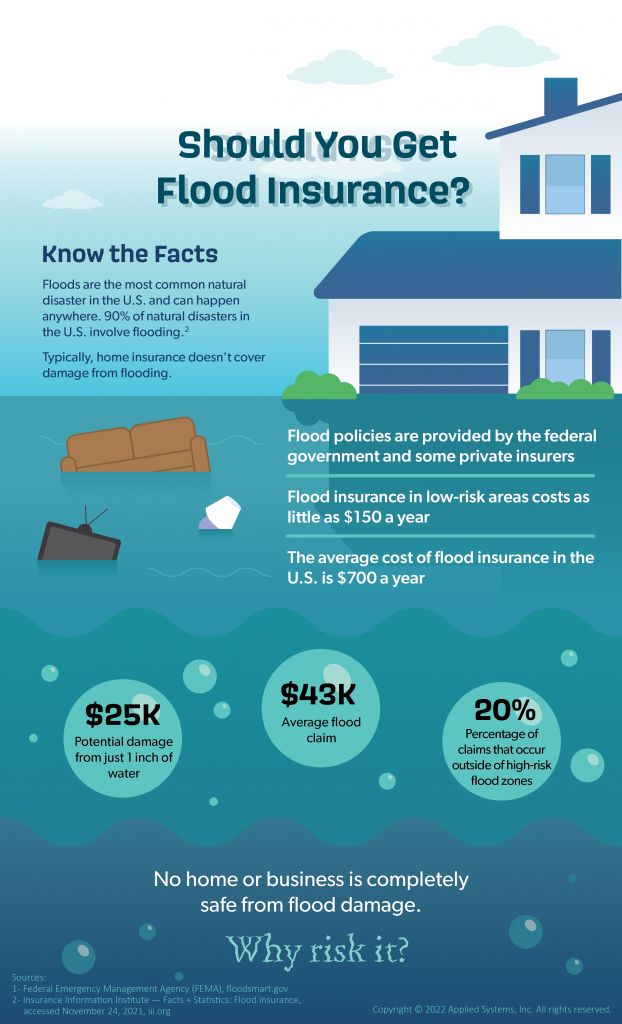After the June 2013 floods in southern Alberta, significant issues with insurance policies and coverage arose. In Alberta, flood insurance policies typically cover flood damaged vehicles and sewage back-up but not overland flooding. Overland flooding occurs when water flows over dry land through doors or windows further damaging property and belongings [1].
Additionally, it was realized that different insurance companies offer different versions of coverage. As a result, the fine print of one insurance policy will differ from specific wording in another, therefore, offering different levels of coverage[2].
Insurance policies and coverage aid in the aftermath of a flood rather than mitigate the event of a flood. Homeowners and businesses claim insurance once damage has resulted from a flood, then depending on coverage, insurance companies will cover costs of that damage. Insurance policies and coverage are utilized after the full extent of damage is realized, making insurance claims part of the response process after flooding occurs.
The June 2013 flood in Alberta resulted in the costliest natural disaster in Canadian history, as estimated by the Insurance Bureau of Canada [3]. For this reason, and because damage caused by natural disasters are increasing, questions of what insurance companies should cover and how rebuilding efforts can continue are being asked to further mitigate the overall impacts and costs of flooding.
Property insurance and processing insurance claims is an unregulated business in the province of Alberta. As a result, insurance companies are able to provide different coverage ranging from basic to full policies [4]. Different insurance companies will use different wording and language in their insurance policies, therefore, making it important for Albertans to review their policies and understand what is and is not included.
The Insurance Bureau of Canada is the nation’s industry association representing insurance companies across Canada. While their role is largely in forecasting and responding to issues and lobbying the federal government, they are a good resource for Albertan’s to contact for further information about insurance claims [5].
In Alberta, the provincial and municipal government is not responsible for flood insurance policies. Instead, numerous private companies exist that provide different levels and types of insurance coverage. There is debate in Alberta about whether or not the provincial government should play a larger role in determining insurance coverage and price, however, no changes have been made.

Insurance policies in Alberta do not operate geographically, instead they operate on an issue-by-issue basis. For example, citizens filing a claim for sewage back-up could be covered while those looking for overland flooding compensation are not covered [6]. Across Alberta and even Canada this remains the policy, therefore, different jurisdictions are not taken into account.
In Alberta, there are numerous private companies competing for customers within the Province [7]. Differences in price, coverage and service between each company lead Albertans to shop around for the right insurance policy for their home or car. Specifically, flood insurance is less common in Alberta as many people do not live in flood-prone areas. After the 2013 flood event, however, flood maps have been revisited by insurers, homeowners, as well as municipal and provincial levels of government to determine potential coverage options.
In Alberta, overland flood insurance is not provided by private insurance companies, therefore it is not enforceable. Other jurisdictions, however, such as the United States, United Kingdom, Germany, France and Australia have different variations of optional flood insurance coverage [8]. For example, German homeowners are offered optional insurance that is bundled with other natural disasters yet separate from property insurance [9].
Flood insurance policies do not impact the surrounding environment and watershed. Instead, flood insurance helps homeowners in the recovery process to rebuild after flood damage.
Insurance policies for overland flooding would not help in a drought. To remain relevant and credible, however, insurers are considering new products to address natural disasters that are on the rise [10].
We provide Canadian educational resources on water practices to promote conservation and sustainability. Our team crafts current and relevant content, while encouraging feedback and engagement.
The Canada WaterPortal is a registered charity, #807121876RR0001
We recognize and respect the sovereignty of the Indigenous Peoples and communities on whose land our work takes place.
© 2025 All Rights Reserved.